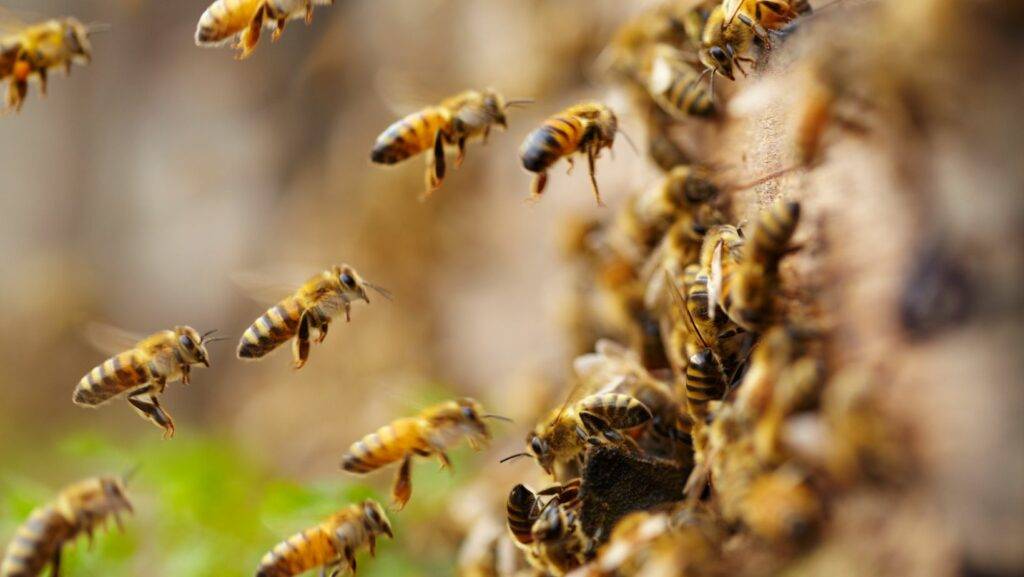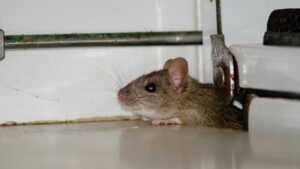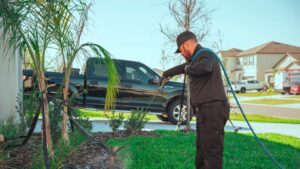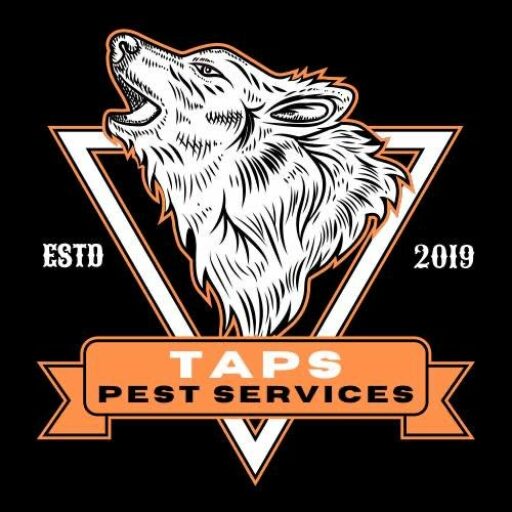Bee Relocation – Safe & Humane Bee Removal
Expert Bee Relocation Services to Protect Your Property and Pollinators
At Taps Pest Control, we provide professional Bee Relocation services to safely remove and relocate bees without harming their colonies. Bees play a crucial role in pollination and the ecosystem, but when they build hives in hazardous locations, relocation is necessary. Our team uses eco-friendly and humane methods to ensure bees are moved safely to new environments where they can continue to thrive.

- Bee Relocation
1.
Safe Hive Removal & Transport
- Careful extraction of bee colonies and relocation to a safe, designated area.
2.
Structural & Property Assessments
- Inspection of homes and buildings to identify hive locations and prevent future infestations.
3.
Preventative Solutions & Repairs
- Sealing hive entry points and implementing deterrents to stop bees from returning.
Expert Tips & Advice for Effective Bee Relocation
Why Choose Taps Pest Control for Bee Relocation?

Bees are essential for our environment, but unmanaged hives can pose safety risks. At Taps Pest Control, we specialize in Bee Relocation, ensuring that bees are removed without extermination and transferred to a safe, sustainable location. We prioritize humane and eco-conscious removal techniques, helping both homeowners and beekeepers protect these valuable pollinators.
Signs You Need Professional Bee Relocation
Recognizing the signs of an unwanted hive early can prevent potential property damage, reduce health risks, and ensure a smooth relocation process. Here are the key indicators that professional Bee Relocation is needed:
- Increased Bee Activity Near Your Home: If you notice an unusually high number of bees hovering near specific areas such as walls, eaves, tree branches, or entry points, it could indicate that a colony is forming nearby.
- Persistent Buzzing Sounds in Walls, Attics, or Chimneys: Bees often establish colonies inside walls, attics, or roof voids. If you hear a consistent buzzing noise within your home’s structure, it may be a sign of a growing hive inside.
- Visible Honeycomb Structures or Swarming Bees: Discovering honeycombs in roof eaves, tree hollows, or even on exterior walls is a clear indication that a colony is established. Swarming bees around your property can also signal an active hive nearby.
- Honey or Wax Seepage from Walls or Ceilings: When bees build hives within the structure of a building, honey and wax can start seeping through walls, leading to damage and attracting pests such as ants and rodents.
- Unusual Pollen Deposits Around Entryways or Windows: Worker bees transport pollen to and from the hive, and if you notice excessive pollen accumulation around windowsills, door frames, or ventilation points, there might be a hidden hive.
- Frequent Sightings of Dead Bees Indoors or Near Entry Points: Finding multiple dead bees near doorways, windows, or air vents suggests that a colony may be located within the walls or attic of your home.
- Aggressive Bee Behavior: While honeybees are generally not aggressive, they may become defensive if they feel their hive is threatened. If you or your pets experience sudden and frequent stings, it could mean that a colony is nearby and should be professionally relocated.
- Presence of Other Insects Feeding on Honey or Wax: Secondary infestations by ants, moths, or beetles that feed on honey and wax often indicate that there is an unmanaged bee hive within your property.
- Seasonal Swarming Activity Near Your Home or Business: Bee swarms commonly occur in spring and summer when colonies divide and seek a new nesting site. If you observe a large cluster of bees gathering in a specific area, professional intervention is necessary to relocate them before they settle permanently.
If you notice any of these signs, contacting a professional Bee Relocation service promptly can help prevent damage and ensure the bees are safely removed without harm. Taps Pest Control provides expert, humane bee removal solutions to protect both your property and the environment. Recognizing the signs of an unwanted hive can help prevent damage and ensure a safe relocation:
- Increased Bee Activity Near Your Home: Seeing a large number of bees hovering near entry points, walls, or trees suggests an established colony.
- Buzzing Sounds in Walls or Attics: Hives in hidden spaces often produce an audible buzzing, particularly in warm weather.
- Visible Honeycomb Structures: Honeycombs found in roof eaves, tree hollows, or wall voids indicate an active colony.
- Honey or Wax Seepage: If you notice honey dripping from walls or ceilings, a hive may be present inside your structure.
How to Prevent Bee Colonies from Nesting on Your Property
Preventing bee infestations before they occur is essential for avoiding unnecessary removals and ensuring a safe environment for both humans and bees. By taking proactive measures, you can significantly reduce the likelihood of bees nesting in unwanted areas while still supporting their role in nature. Follow these expert-recommended steps:
- Seal Openings in Walls & Roofs: Bees can enter through even the smallest gaps. Regularly inspect your home’s exterior and seal any cracks, crevices, or holes in walls, roofs, and attics.
- Trim Vegetation & Remove Hollow Spaces: Bees prefer nesting in shaded, undisturbed areas. Trim overgrown trees, remove old logs, and clear away debris that may serve as potential hive locations.
- Use Natural Deterrents: Certain scents, such as peppermint, citronella, cinnamon, and tea tree oil, are natural bee repellents. Spraying these essential oils around potential nesting sites can help deter bees.
- Install Mesh Screens & Barriers: Place fine mesh screens over vents, chimneys, and soffits to prevent bees from accessing interior spaces like attics and crawl spaces.
- Eliminate Unused Outdoor Structures: Discard unused outdoor equipment like old sheds, hollow fence posts, or abandoned furniture, which can provide shelter for swarming bees.
- Limit Access to Water Sources: Bees require water for hive maintenance. Fix leaky faucets, cover pools when not in use, and avoid leaving out standing water to make your property less attractive to them.
- Keep Sweet & Sugary Substances Sealed: Bees are drawn to sugary liquids. Keep trash bins tightly closed, avoid leaving out soda cans or juice containers, and promptly clean up spills.
- Encourage Proper Hive Placement: If you want to support local bee populations, consider setting up artificial hives or bee boxes in designated areas far from high-traffic zones.
- Monitor Seasonal Swarming Activity: Bees typically swarm in spring and summer when colonies outgrow their hives. Stay vigilant during these months and address any signs of bee activity early.
- Schedule Regular Property Inspections: Routine inspections by pest control professionals can identify potential nesting risks and implement preventive measures before an infestation develops.
Taking these preventive steps will help protect your home from unwanted bee colonies while fostering an environment where bees can safely thrive in appropriate locations. If you suspect bee activity near your property, early intervention with professional guidance can make a significant difference in long-term prevention. Preventing bee infestations is the best way to avoid unnecessary removals. Follow these steps:
- Seal Openings in Walls & Roofs: Close off small gaps and holes where bees could build hives.
- Trim Vegetation & Remove Hollow Spaces: Overgrown trees and abandoned wood structures provide ideal nesting spots for bees.
- Use Natural Deterrents: Strong scents like peppermint, cinnamon, and citrus can deter bees from settling in unwanted areas.
- Schedule Routine Property Inspections: Regularly checking high-risk areas like attics, sheds, and trees can help prevent hive formation.
The Importance of Ethical Bee Relocation
Ethical Bee Relocation is essential not only for protecting homeowners and businesses but also for ensuring the survival of vital pollinators. Unlike extermination, which eliminates bees and disrupts ecosystems, humane relocation methods help maintain biodiversity and agricultural productivity. The following are key reasons why ethical bee relocation should always be prioritized:
- Preserves Bee Populations: Bees are crucial to the environment, contributing to over 75% of global food crop pollination. With bee populations declining due to habitat loss, pesticides, and climate change, relocating colonies instead of exterminating them supports ecological balance and food production.
- Reduces Structural Damage: Colonies that have nested in walls, attics, or within commercial buildings can cause long-term structural issues, including honey seepage, weakened insulation, and infestations from pests drawn to abandoned hives. Ethical relocation ensures that these problems are addressed while keeping the bees alive.
- Minimizes Public Health Risks: Large bee colonies can pose a risk to residents, employees, and customers, especially for individuals allergic to bee stings. Removing bees in a humane manner prevents aggressive defensive behaviors while avoiding the dangers of harmful pesticides.
- Supports Sustainable Agriculture: Farmers and gardeners depend on bees for crop pollination. Ethical bee relocation programs work with local beekeepers and conservation groups to ensure that relocated bees continue to contribute to agricultural success.
- Prevents Unnecessary Extermination: Traditional pest control methods often involve toxic chemicals that harm not only the bees but also the surrounding environment, other beneficial insects, and even humans. Relocating bees to safe and managed environments reduces the need for chemical interventions.
- Encourages Coexistence with Pollinators: Many people are unaware that bees can be safely removed and relocated rather than killed. Raising awareness and providing proper education about ethical bee relocation helps communities make informed, eco-friendly decisions that benefit both humans and nature.
- Ensures Compliance with Local Regulations: In many regions, laws protect honeybees due to their environmental importance. Using professional bee relocation services ensures compliance with these regulations, avoiding potential fines and legal issues associated with extermination.
By choosing ethical Bee Relocation services, you’re making a responsible choice that benefits both your property and the environment. Supporting safe and humane removal techniques ensures that bee populations thrive while preventing unwanted infestations in homes and businesses. Unlike traditional extermination methods, ethical Bee Relocation benefits both property owners and the environment. Here’s why humane relocation is essential:
- Protects Bee Populations: Bees are declining due to habitat loss and pesticides. Relocating colonies ensures their survival.
- Prevents Structural Damage: Unmanaged hives can lead to melted wax, honey seepage, and compromised building structures.
- Reduces Stinging Risks: Relocating aggressive or displaced colonies protects residents, pets, and businesses from potential stings.
- Supports Local Agriculture: Many farms and orchards rely on bee pollination to sustain crops.
Understanding Bee Behavior and Hive Structure
Bees are incredibly intelligent and social insects that operate within a well-organized hierarchy. Understanding their behavior and hive structure is crucial to ensuring a successful Bee Relocation process. Each colony functions as a highly efficient unit, with distinct roles assigned to different members of the hive.
The Hierarchy of a Bee Colony
A bee colony is made up of three primary types of bees:
- The Queen Bee: The queen is the single most important member of the colony. She is responsible for laying eggs and ensuring the hive continues to grow. A healthy queen can lay up to 2,000 eggs per day during peak seasons.
- Worker Bees: These female bees make up the majority of the colony and perform a variety of tasks, including foraging for nectar and pollen, producing honey, maintaining the hive, feeding the queen and larvae, and defending the hive from threats.
- Drone Bees: Male bees that exist primarily for mating with a queen from another hive. Once they have fulfilled this role, they typically die, as they do not contribute to other hive activities.
The Structure of a Beehives
Beehives are meticulously designed and serve multiple functions:
- Honeycomb Cells: Made from beeswax, the hexagonal cells store honey, pollen, and developing bee larvae.
- Brood Chamber: The area within the hive where the queen lays eggs and new bees develop.
- Entrance Guard Area: Worker bees stand guard at the hive entrance, preventing intruders from entering.
- Foraging and Nectar Storage Zones: Worker bees collect nectar from flowers, which is then stored in the hive and processed into honey.
Swarming and Hive Expansion Patterns
Bees expand their hives based on available space and environmental conditions. If a hive becomes overcrowded, the colony will undergo a process known as swarming, where a new queen and a group of worker bees leave to establish a new hive elsewhere. This is one of the most common reasons for unwanted bee infestations in homes and businesses.
Seasonal Hive Activity
The level of bee activity varies throughout the year:
- Spring & Summer: These are the busiest seasons for bee colonies. During this time, hive populations grow, and foraging activity increases.
- Fall: Bees begin preparing for winter by increasing honey production and fortifying their hive structure.
- Winter: Hive activity slows down as bees cluster together to maintain warmth. Unlike other insects, bees do not hibernate but instead stay inside the hive, surviving on stored honey.
Foraging and Pollination Patterns
Bees travel significant distances to gather nectar and pollen:
- Foraging Range: A single bee can fly up to five miles from the hive in search of flowers.
- Pollination Cycles: Bees play a vital role in plant reproduction by transferring pollen between flowers, allowing fruits and vegetables to develop.
- Preferred Plants: Bees are particularly attracted to flowers rich in nectar, including lavender, sunflowers, and fruit blossoms.
Understanding these behaviors and patterns helps ensure that Bee Relocation is performed effectively, with minimal disruption to both the bees and their environment. Relocating a hive at the right time and to a suitable location supports the continued survival of the colony while preventing them from re-establishing in unwanted areas. To successfully relocate bees, it is essential to understand how they operate:
- Bee Colony Hierarchy: A hive consists of a queen, worker bees, and drones, each playing a vital role in sustaining the colony.
- Hive Expansion Patterns: Bees will expand their hive when it becomes overcrowded, leading to swarming.
- Swarm Behavior: Swarms occur when a colony splits, with half of the bees seeking a new home, which is when relocation is crucial.
- Seasonal Hive Activity: Bees are most active in spring and summer when their populations grow and food sources are abundant.
- Foraging Patterns: Bees can travel up to five miles searching for nectar and pollen, making relocation site selection important.
Best Practices for Long-Term Bee Prevention
Ensuring that bees do not return after a relocation is crucial for maintaining a safe and bee-free environment. Implementing long-term prevention strategies can help keep your property protected while still supporting local bee populations in appropriate locations.
- Repair Entry Points & Structural Gaps: Bees often find their way into homes and structures through small openings. Seal cracks in walls, roofs, eaves, and ventilation points to eliminate access points.
- Remove Old Hive Remnants: Even after a successful Bee Relocation, leftover honeycomb and wax can attract new swarms. Ensure that all remnants of the previous hive are removed and the area is thoroughly cleaned.
- Use Natural Bee Deterrents: Certain smells and materials discourage bees from nesting. Applying essential oils like peppermint, citronella, or tea tree oil around potential nesting spots can help prevent future colonies.
- Install Physical Barriers: Mesh screens, chimney caps, and fine wire netting can be placed over openings where bees may try to enter, such as attic vents and crawl spaces.
- Avoid Leaving Out Sweet or Sugary Substances: Open soda cans, juice containers, or sugary foods can attract scout bees searching for new hive locations. Keep these items sealed and disposed of properly.
- Plant Bee-Friendly Gardens Away from Living Spaces: Supporting pollinators is important, but it is best to keep flowering plants, especially those that produce nectar, at a distance from your home. Consider setting up a designated pollination area in a less trafficked portion of your property.
- Monitor High-Risk Areas Regularly: Bees often return to previous nesting spots if the conditions remain favorable. Conduct seasonal inspections of eaves, attics, trees, and exterior walls to catch early signs of new colony formation.
- Encourage Professional Hive Placement: If you appreciate bees and their pollination benefits, consider working with a local beekeeper to install hive boxes in controlled areas away from your living spaces. This helps keep bee populations healthy while preventing them from nesting in unwanted locations.
- Educate Your Community: Bees are an essential part of our ecosystem, and promoting awareness about humane bee relocation and prevention strategies within your neighborhood can reduce the likelihood of harmful extermination practices.
By following these Best Practices for Long-Term Bee Prevention, you can ensure that your property remains bee-free while contributing to the preservation of these vital pollinators. After a successful Bee Relocation, follow these steps to avoid re-infestations:
- Repair Entry Points: Seal off small holes, cracks, or open cavities that bees could use for nesting.
- Remove Old Hive Residue: Clean and disinfect areas where a previous hive was located to remove lingering pheromones that attract new swarms.
- Install Decoy Hives or Bee Houses: If you want to support bee populations without them settling in inconvenient areas, set up bee-friendly habitats in designated locations.
- Work with Local Beekeepers: Collaborate with professional beekeepers who can advise on safe, responsible bee deterrence and relocation techniques.
- Monitor Property Regularly: Conduct seasonal inspections, particularly in warm months when bee activity is high.
Steps to Take If You Discover a Bee Colony
If you discover a bee colony on your property, taking the right steps is crucial for both safety and the successful relocation of the hive. Bees are generally not aggressive unless they feel threatened, so it’s important to handle the situation with care.
- Assess the Hive Location & Activity: Observe where the bees are gathering. Are they near an entry point to your home, such as a vent or wall void, or are they nesting in a tree or an outdoor structure? Identifying the exact location of the colony can help in determining the safest approach for removal.
- Remain Calm & Keep Your Distance: Avoid sudden movements or loud noises that could disturb the colony. Swatting at bees or attempting to move their hive yourself can cause them to become defensive, increasing the risk of stings.
- Protect Pets & Family Members: If the hive is in an area where children or pets frequently pass by, keep them away from the hive to prevent accidental disturbances. If necessary, block off the area until professionals arrive.
- Do Not Attempt DIY Removal: Unlike wasp nests, bee hives require careful handling to preserve the colony. Spraying insecticides or using household items to remove the hive can harm the bees and cause environmental damage.
- Monitor for Aggressive Behavior: Most honeybees are not aggressive unless provoked. However, if you notice increased aggression, such as bees swarming individuals near the hive, it may indicate the presence of a more defensive species, such as Africanized honeybees. In such cases, immediate professional assistance is necessary.
- Avoid Blocking Entry Points Prematurely: If bees have nested inside a structure, resist the urge to seal off entry points before professional removal. Trapping bees inside a wall or attic can lead to further complications, including hive decay, honey seepage, and secondary infestations from pests attracted to abandoned honeycombs.
- Identify the Type of Bees: If possible, observe the bees from a safe distance to identify their species. Honeybees, bumblebees, carpenter bees, and wasps can all look similar. If the insects are large, fuzzy, and slow-moving, they are likely bumblebees. If they are burrowing into wooden surfaces, they may be carpenter bees, which require different control measures.
- Call a Professional Bee Relocation Service: The safest and most effective way to handle a bee infestation is to contact Taps Pest Control. Our Bee Relocation experts use humane and eco-friendly methods to remove and relocate bees to suitable environments where they can continue to thrive.
- Follow Up with Preventative Measures: After relocation, ensure that potential nesting areas are sealed, and old hive remnants are removed. Work with professionals to implement long-term bee prevention strategies to keep future colonies from forming in unwanted locations.
By following these steps, you can ensure a smooth and safe Bee Relocation process that protects both your property and the bee population.
Call Now: (813) 592-7643 for expert Bee Relocation services! If you find a bee hive on your property, follow these safety precautions:
- Stay Calm & Avoid Disturbing the Hive: Sudden movements or vibrations can agitate the colony, increasing the risk of stings.
- Keep a Safe Distance: Avoid standing too close to a hive, especially if it’s near doors, windows, or pathways.
- Do Not Use Pesticides or Sprays: Many commercial sprays kill bees and are harmful to the environment.
- Call a Professional: Contact Taps Pest Control for expert Bee Relocation to safely remove and transport the colony to a suitable environment.
Get Professional Bee Relocation with Taps Pest Control – Call Now!
Protect both your home and the environment with expert Bee Relocation services from Taps Pest Control. We ensure safe and effective bee removal without harming these essential pollinators.
Additional Resources

Effective Pest Control Tips From Taps Pest Control
Are you tired of dealing with unwelcome visitors like insects and rodents in your home? Pest infestations can quickly turn your space into a stressful environment, especially if they take over areas like the attic or kitchen. In this guide, we will share effective pest control tips to help you keep your kitchen free of pests, ensure bathroom sanitation, and prevent stagnant water accumulation. By following these tips, you can create a healthier and safer home while reducing the risk of future infestations from cockroaches and other pests.

Ultimate Pest Control Tips for Florida Homeowners: How to Stop Infestations Before They Start
Tired of insects, rodents, and pests invading your Florida home? Discover expert pest control tips from Taps Pest Control to stop infestations before they start.

Spring Pest Control in Florida: Pest Prevention Tips
Get ahead of the season with expert spring pest control in Florida. As temperatures rise, so does pest activity—especially ants, termites, and mosquitoes. Learn how to protect your home with inspection tips, prevention checklists, and professional solutions from Taps Pest Services.
Frequently Asked Questions About Bee Relocation
Is Bee Relocation Safe for the Bees?
Yes! Our Bee Relocation methods prioritize the safety of bees, ensuring they are moved without harm.
How Long Does the Bee Relocation Process Take?
Most relocations are completed within one to three hours, depending on the hive’s size and location.
Will the Bees Return After Relocation?
No, once a hive is removed and the entry points are sealed, bees will not return to the same location.
What Happens to the Bees After They Are Relocated?
We work with local beekeepers and conservation groups to relocate bees to safe, managed habitats where they can continue to pollinate and thrive.
How Do I Schedule a Bee Relocation Service?
Call (813) 592-7643 today to schedule expert Bee Relocation services and keep your property safe.



